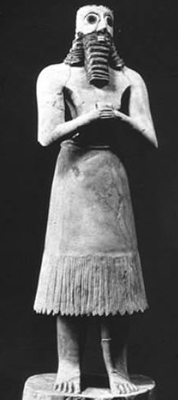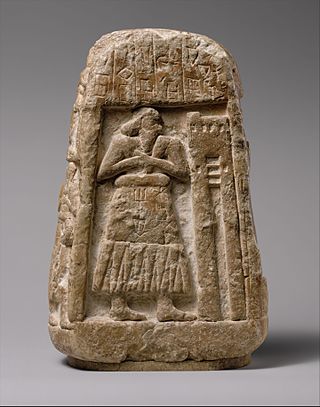
Ninḫursaĝ sometimes transcribed Ninursag, Ninḫarsag, or Ninḫursaĝa, also known as Damgalnuna or Ninmah, was the ancient Sumerian mother goddess of the mountains, and one of the seven great deities of Sumer. She is known earliest as a nurturing or fertility goddess. Temple hymn sources identify her as the "true and great lady of heaven" and kings of Lagash were "nourished by Ninhursag's milk". She is the tutelary deity to several Sumerian leaders.
Nammu was a Mesopotamian goddess regarded as a creator deity in the local theology of Eridu. It is assumed that she was associated with water. She is also well attested in connection with incantations and apotropaic magic. She was regarded as the mother of Enki, and in a single inscription she appears as the wife of Anu, but it is assumed that she usually was not believed to have a spouse.

Dilmun, or Telmun, was an ancient East Semitic-speaking civilization in Eastern Arabia mentioned from the 3rd millennium BC onwards. Based on contextual evidence, it was located in the Persian Gulf, on a trade route between Mesopotamia and the Indus Valley civilisation, close to the sea and to artesian springs. Dilmun encompassed Bahrain, Kuwait, and eastern Saudi Arabia. This area is certainly what is meant by references to "Dilmun" among the lands conquered by King Sargon II and his descendants.

Shala (Šala) was a Mesopotamian goddess of weather and grain and the wife of the weather god Adad. It is assumed that she originated in northern Mesopotamia and that her name might have Hurrian origin. She was worshiped especially in Karkar and in Zabban, regarded as cult centers of her husband as well. She is first attested in the Old Babylonian period, but it is possible that an analogous Sumerian goddess, Medimsha, was already the wife of Adad's counterpart Ishkur in earlier times.

Failaka Island is a Kuwaiti Island in the Persian Gulf. The island is 20 km off the coast of Kuwait City in the Persian Gulf. The name "Failaka" is thought to be derived from the ancient Greek φυλάκιο(ν) – fylakio(n) "outpost".

Nanshe was a Mesopotamian goddess in various contexts associated with the sea, marshlands, the animals inhabiting these biomes, namely bird and fish, as well as divination, dream interpretation, justice, social welfare, and certain administrative tasks. She was regarded as a daughter of Enki and sister of Ningirsu, while her husband was Nindara, who is otherwise little known. Other deities who belonged to her circle included her daughter Nin-MAR.KI, as well as Hendursaga, Dumuzi-abzu and Shul-utula. In Ur she was incorporated into the circle of Ningal, while in incantations she appears alongside Ningirima or Nammu.
Agarum is a bronze-age Near Eastern proper name, probably a toponym for a region or island in the Eastern Arabia and Persian Gulf. Agarum has been generally identified with Kuwait's Failaka Island, known as ´KR to the Arameans and as Ikaros during the Hellenistic times. Failaka's Ekara temple is another probable location. Agarum is sometimes identified with the mediaeval city of Haǧar, in the general region of Al-Ahsa Oasis in Saudi Arabia and Bahrain Island in Bahrain.
Ninti was a Mesopotamian goddess worshiped in Lagash. She was regarded as the mother of Ninkasi. She also appears in the myth Enki and Ninhursag as one of the deities meant to soothe the eponymous god's pain. In this text, her name is reinterpreted first as "lady rib" and then as "lady of the month" through scribal word play.

Abu was a Mesopotamian god. His character is poorly understood, though it is assumed he might have been associated with vegetation and with snakes. He was often paired with the deity Gu2-la2, initially regarded as distinct from Gula, but later conflated with her.
Ningirida was a Mesopotamian goddess regarded as the wife of Ninazu and mother of Ningishzida. Little is known about her character beyond her relation to these two gods.

Shara was a Mesopotamian god associated with the city of Umma and other nearby settlements. He was chiefly regarded as the tutelary deity of this area, responsible for agriculture, animal husbandry and irrigation, but he could also be characterized as a divine warrior. In the third millennium BCE his wife was Ninura, associated with the same area, but later, in the Old Babylonian period, her cult faded into obscurity and Shara was instead associated with Usaḫara or Kumulmul. An association between him and Inanna is well attested. In Umma, he was regarded as the son of Inanna of Zabalam and an unknown father, while in the myth Inanna's Descent to the Underworld he is one of the servants mourning her temporary death. He also appears in the myth of Anzû, in which he is one of the three gods who refuse to fight the eponymous monster.
Šulpae was a Mesopotamian god. Much about his role in Mesopotamian religion remains uncertain, though it is agreed he was an astral deity associated with the planet Jupiter and that he could be linked to specific diseases, especially bennu. He was regarded as the husband of Ninhursag. Among the deities considered to be their children were Ashgi, Panigingarra and Lisin. The oldest texts which mention him come from the Early Dynastic period, when he was worshiped in Kesh. He is also attested in documents from other cities, for example Nippur, Adab and Girsu. Multiple temples dedicated to him are mentioned in known sources, but their respective locations are unknown.
Manzat (Manzât), also spelled Mazzi'at, Manzi'at and Mazzêt, sometimes known by the Sumerian name Tiranna (dTIR.AN.NA) was a Mesopotamian and Elamite goddess representing the rainbow. She was also believed to be responsible for the prosperity of cities.
Simut or Šimut (Shimut) was an Elamite god. He was regarded as the herald of the gods, and was associated with the planet Mars. He was also worshiped in Mesopotamia, where he was compared with the war god Nergal.
Lagamal or Lagamar was a Mesopotamian deity associated chiefly with Dilbat. A female form of Lagamal was worshiped in Terqa on the Euphrates in Upper Mesopotamia. The male Lagamal was also at some point introduced to the pantheon of Susa in Elam.
Ninmug or Ninmuga was a Mesopotamian goddess. She was associated with artisanship, especially with metalworking, as evidenced by her epithet tibira kalamma, "metalworker of the land." She could also be regarded as a goddess of birth and assistant of Ninmah, most likely because the fashioning of statues of deities and the birth of children could be described with the same terms in Sumerian texts. Her main cult centers were Kisiga, whose location remains uncertain, and Adab.
Belet-Šuḫnir and Belet-Terraban were a pair of Mesopotamian goddesses best known from the archives of the Third Dynasty of Ur, but presumed to originate further north, possibility in the proximity of modern Kirkuk and ancient Eshnunna. Their names are usually assumed to be derived from cities where they were originally worshiped. Both in ancient sources, such as ritual texts, seal inscriptions and god lists, and in modern scholarship, they are typically treated as a pair. In addition to Ur and Eshnunna, both of them are also attested in texts from Susa in Elam. Their character remains poorly understood due to scarcity of sources, though it has been noted that the tone of many festivals dedicated to them was "lugubrious," which might point at an association with the underworld.
Ninsikila was a Mesopotamian deity regarded as the spouse of Lisin. Early sources refer to him as male, but later on the name came to refer to a goddess instead. The change in gender might have been influenced by an association with the Dilmunite goddess Meskilak, also called Ninsikila in Mesopotamia, or by Lisin's placement before her spouse in god lists. Texts attesting the worship of Ninsikila include an inscription from Larsa and a magical formula from Meturan.
Meskilak or Mesikila was one of the two main deities worshiped in Dilmun. The other well attested member of the pantheon of this area was Inzak, commonly assumed to be her spouse. The origin of her name is a subject of scholarly dispute. She is also attested in texts from Mesopotamia, where her name was reinterpreted as Ninsikila. A different deity also named Ninsikila was the spouse of Lisin, and might have started to be viewed as a goddess rather than a god due to the similarity of the names. Under her Mesopotamian name Meskilak appears in the myths Enki and Ninhursag and Enki and the World Order, in which she is associated with Dilmun.
Lugala'abba or Lugalabba was a Mesopotamian god associated with the sea, as well as with the underworld. It has been proposed that he was worshiped in Nippur. He is also attested in various god lists, in a seal inscription, and in the incantation series Šurpu.








